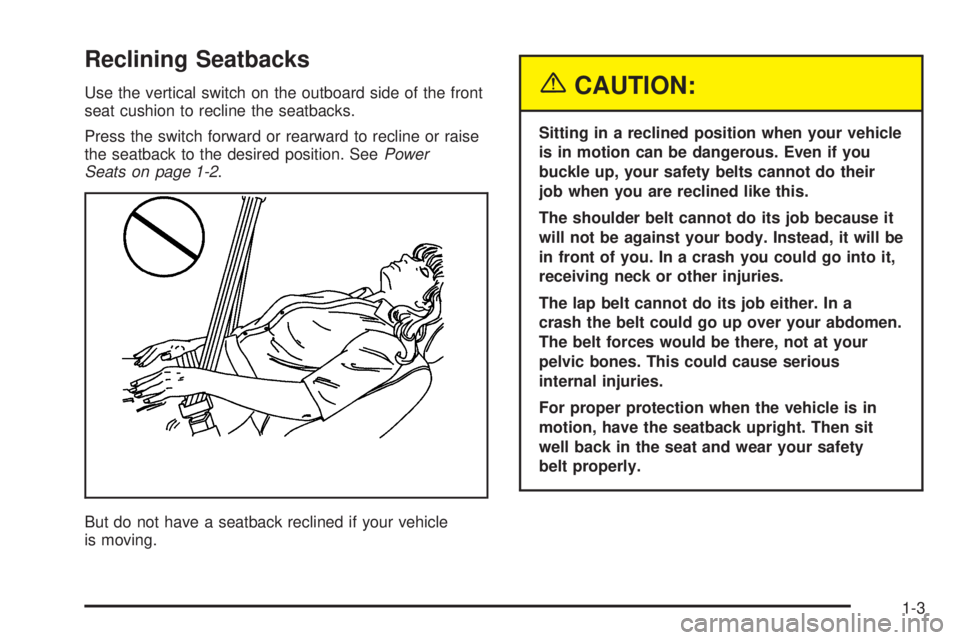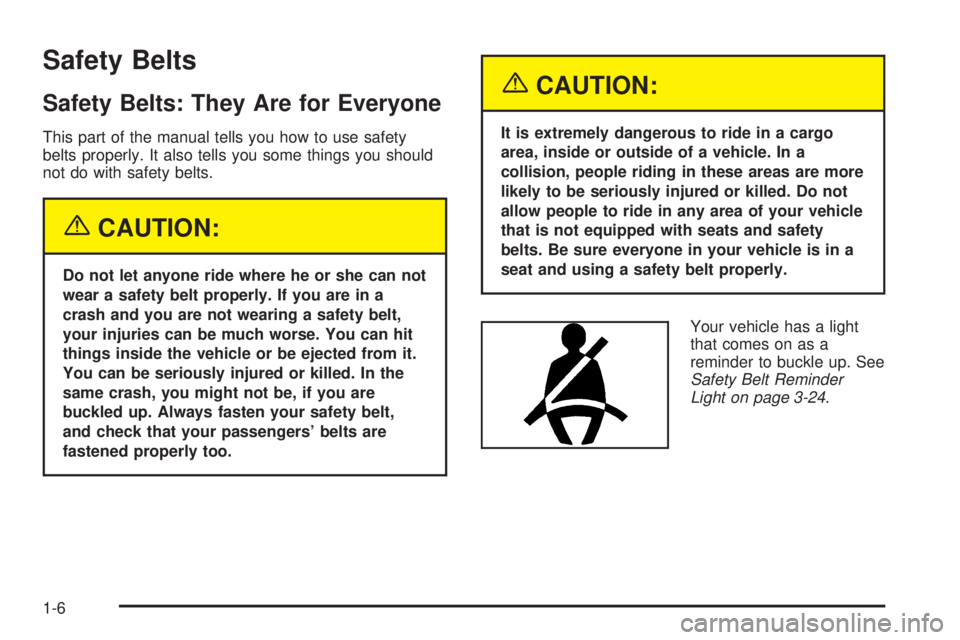2005 PONTIAC GTO seats
[x] Cancel search: seatsPage 1 of 318

Seats and Restraint Systems........................... 1-1
Front Seats
............................................... 1-2
Safety Belts
.............................................. 1-6
Child Restraints
.......................................1-25
Airbag System
.........................................1-44
Restraint System Check
............................1-50
Features and Controls..................................... 2-1
Keys
........................................................ 2-2
Doors and Locks
....................................... 2-7
Windows
.................................................2-11
Theft-Deterrent Systems
............................2-13
Starting and Operating Your Vehicle
...........2-15
Mirrors
....................................................2-28
Storage Areas
.........................................2-29
Vehicle Personalization
.............................2-30
Instrument Panel............................................. 3-1
Instrument Panel Overview
.......................... 3-4
Climate Controls
......................................3-19
Warning Lights, Gages, and Indicators
........3-22
Trip Computer
.........................................3-33
Audio System(s)
.......................................3-45Driving Your Vehicle....................................... 4-1
Your Driving, the Road, and Your Vehicle
..... 4-2
Towing
...................................................4-34
Service and Appearance Care.......................... 5-1
Service
..................................................... 5-3
Fuel
......................................................... 5-5
Checking Things Under the Hood
...............5-10
Headlamp Aiming
.....................................5-45
Bulb Replacement
....................................5-47
Windshield Wiper Blade Replacement
.........5-52
Tires
......................................................5-52
Appearance Care
.....................................5-76
Vehicle Identification
.................................5-85
Electrical System
......................................5-85
Capacities and Specifications
.....................5-90
Maintenance Schedule..................................... 6-1
Maintenance Schedule
................................ 6-2
Customer Assistance and Information.............. 7-1
Customer Assistance and Information
........... 7-2
Reporting Safety Defects
...........................7-10
Index................................................................ 1
2005 Pontiac GTO Owner ManualM
Page 4 of 318

Vehicle Damage Warnings
Also, in this manual you will find these notices:
Notice:These mean there is something that could
damage your vehicle.
A notice tells about something that can damage the
vehicle. Many times, this damage would not be covered
by your vehicle’s warranty, and it could be costly. But
the notice will tell what to do to help avoid the damage.
When you read other manuals, you might see
CAUTION and NOTICE warnings in different colors
or in different words.
There are also warning labels on the vehicle. They use
the same words, CAUTION or NOTICE.
Vehicle Symbols
The vehicle has components and labels that use
symbols instead of text. Symbols are shown along with
the text describing the operation or information
relating to a specific component, control, message,
gage, or indicator.
If you need help figuring out a specific name of a
component, gage, or indicator, reference the
following topics:
•Seats and Restraint Systems in Section 1
•Features and Controls in Section 2
•Instrument Panel Overview in Section 3
•Climate Controls in Section 3
•Warning Lights, Gages, and Indicators in Section 3
•Audio System(s) in Section 3
•Engine Compartment Overview in Section 5
iv
Page 7 of 318

Front Seats......................................................1-2
Power Seats..................................................1-2
Manual Lumbar..............................................1-2
Reclining Seatbacks........................................1-3
Head Restraints.............................................1-4
Seatback Latches...........................................1-4
Safety Belts.....................................................1-6
Safety Belts: They Are for Everyone.................1-6
Questions and Answers About Safety Belts......1-10
How to Wear Safety Belts Properly.................1-11
Driver Position..............................................1-12
Shoulder Belt Height Adjustment.....................1-18
Safety Belt Use During Pregnancy..................1-19
Right Front Passenger Position.......................1-19
Rear Seat Passengers..................................1-19
Rear Safety Belt Comfort Guides for
Children and Small Adults..........................1-22
Safety Belt Pretensioners...............................1-24
Child Restraints.............................................1-25
Older Children..............................................1-25
Infants and Young Children............................1-28
Child Restraint Systems.................................1-31Where to Put the Restraint.............................1-34
Top Strap....................................................1-35
Top Strap Anchor Location.............................1-36
Lower Anchorages and Top Tethers for
Children (LATCH System)...........................1-37
Securing a Child Restraint Designed for
the LATCH System....................................1-39
Securing a Child Restraint in a Rear
Seat Position............................................1-39
Securing a Child Restraint in the Right
Front Seat Position....................................1-41
Airbag System...............................................1-44
Where Are the Airbags?................................1-46
When Should an Airbag Inflate?.....................1-47
What Makes an Airbag Inflate?.......................1-48
How Does an Airbag Restrain?.......................1-48
What Will You See After an Airbag Inflates?.....1-48
Servicing Your Airbag-Equipped Vehicle...........1-50
Restraint System Check..................................1-50
Checking the Restraint Systems......................1-50
Replacing Restraint System Parts
After a Crash............................................1-51
Section 1 Seats and Restraint Systems
1-1
Page 8 of 318

Front Seats
Power Seats
The power seat controls are located on the outboard
side of the driver’s and passenger’s seat.
The horizontal switch is used to adjust the height, the
tilt, and the movement of the seat forward and rearward.
The vertical switch is used to adjust the seatback.
•To move the entire seat forward or rearward, move
the horizontal control forward or rearward.
•To raise or lower the entire seat, move the
horizontal control up or down.
•To raise or lower the front of the seat, move the
front of the horizontal control up or down.
•To raise or lower the rear of the seat, move the
rear of the horizontal control up or down.
•To raise or recline the seatback, move the vertical
control forward or rearward. SeeReclining
Seatbacks on page 1-3.
Manual Lumbar
The manual lumbar
control lets you adjust the
amount of support in
the lower seatback.
The control is located on the outboard side of the
seat cushion.
To increase or decrease lumbar support, turn the knob.
1-2
Page 9 of 318

Reclining Seatbacks
Use the vertical switch on the outboard side of the front
seat cushion to recline the seatbacks.
Press the switch forward or rearward to recline or raise
the seatback to the desired position. SeePower
Seats on page 1-2.
But do not have a seatback reclined if your vehicle
is moving.{CAUTION:
Sitting in a reclined position when your vehicle
is in motion can be dangerous. Even if you
buckle up, your safety belts cannot do their
job when you are reclined like this.
The shoulder belt cannot do its job because it
will not be against your body. Instead, it will be
in front of you. In a crash you could go into it,
receiving neck or other injuries.
The lap belt cannot do its job either. In a
crash the belt could go up over your abdomen.
The belt forces would be there, not at your
pelvic bones. This could cause serious
internal injuries.
For proper protection when the vehicle is in
motion, have the seatback upright. Then sit
well back in the seat and wear your safety
belt properly.
1-3
Page 10 of 318

Head Restraints
The head restraints on both the front and rear seats are
adjustable. Press the button at the base of the head
restraint to lower it. Pull up on the restraint to raise it.
Adjust the head restraint so that the top of the restraint
is closest to the top of your head. This position
reduces the chance of a neck injury in a crash.
Seatback Latches
The front seatbacks fold
forward to let people get
into the back seat.
To fold a front seatback, lift the lever located near the
top of either front seat to tilt the seatback forward. Press
and hold the button located below the seatback lever
to move the entire seat forward all the way.
A weight sensor has been built into the front seats.
The seat will not move forward if there is more than
27 lbs (12 kg) on the seat sensor.
1-4
Page 12 of 318

Safety Belts
Safety Belts: They Are for Everyone
This part of the manual tells you how to use safety
belts properly. It also tells you some things you should
not do with safety belts.
{CAUTION:
Do not let anyone ride where he or she can not
wear a safety belt properly. If you are in a
crash and you are not wearing a safety belt,
your injuries can be much worse. You can hit
things inside the vehicle or be ejected from it.
You can be seriously injured or killed. In the
same crash, you might not be, if you are
buckled up. Always fasten your safety belt,
and check that your passengers’ belts are
fastened properly too.
{CAUTION:
It is extremely dangerous to ride in a cargo
area, inside or outside of a vehicle. In a
collision, people riding in these areas are more
likely to be seriously injured or killed. Do not
allow people to ride in any area of your vehicle
that is not equipped with seats and safety
belts. Be sure everyone in your vehicle is in a
seat and using a safety belt properly.
Your vehicle has a light
that comes on as a
reminder to buckle up. See
Safety Belt Reminder
Light on page 3-24.
1-6
Page 18 of 318

Driver Position
Lap-Shoulder Belt
The driver has a lap-shoulder belt. Here is how to wear
it properly.
1. Close and lock the door.
2. Adjust the seat so you can sit up straight. To see
how, see “Seats” in the Index.
3. Pick up the latch plate and pull the belt across you.
Do not let it get twisted.The shoulder belt may lock if you pull the belt
across you very quickly. If this happens, let the belt
go back slightly to unlock it. Then pull the belt
across you more slowly.
4. Push the latch plate into the buckle until it clicks.
Pull up on the latch plate to make sure it is secure.
Make sure the release button on the buckle is
positioned so you would be able to unbuckle the
safety belt quickly if you ever had to.
5. Move the shoulder belt height adjuster to the height
that is right for you. SeeShoulder Belt Height
Adjustment on page 1-18.
1-12